retired Swedish geoscientist, industry leader, consultant, Professor, and
internationally recognized expert on “Quick Clay”, Dr. Stig Bernander, spent three days studying what he described as a “live” land mass on the lower Churchill River. He was able to personally view, on the ground and from the air, a great many landslides and see physical evidence of active movement over a large area including the “North Spur”.
another four days editing his notes, selecting photographic evidence and lecturing at the LSPU
Hall and at Memorial University on the dangers of Nalcor relying upon “outdated”
geotechnical analysis of the problem.
person of the stature of Dr. Bernander, having no connection to this Province, is troubled enough
to perform this public service, pro bono, you have a right to think there is cause for
concern.
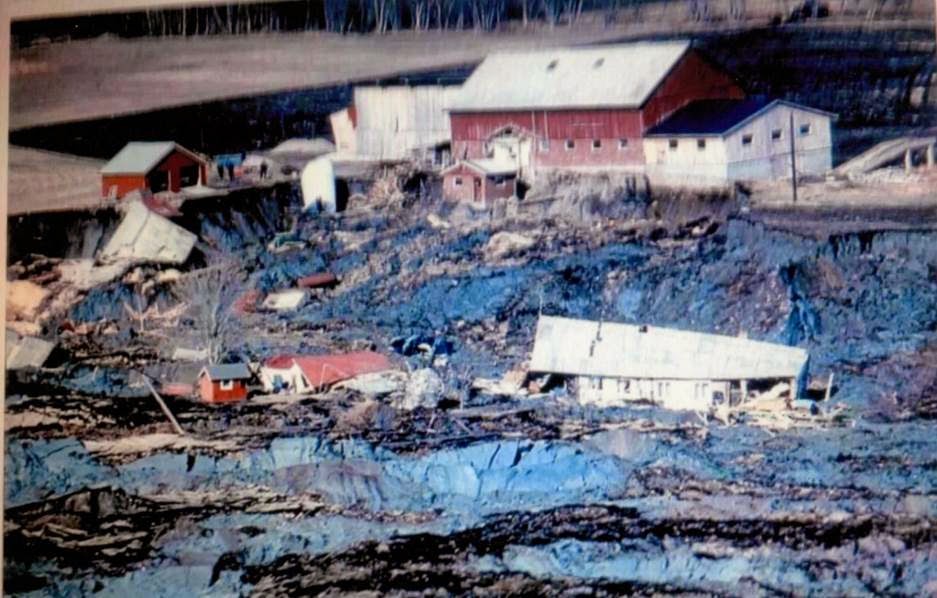 |
| Rissa slide, Norway
|
When the
Vice-President of Nalcor, Gilbert Bennett, shows up at Dr. Bernander’s lecture
at Memorial University, not to welcome the man or to acknowledge his internationally accepted engineering models for assessing landslide risk, not even to ask him a question, but only to express umbrage against the Professor,
you know the Corporation has gotten far too used to not being challenged by competent third parties.
Nalcor’s V-P later played defense on the public airwaves rather
than produce comprehensive scientific evidence to allay Dr. Bernander concerns.
Part of the concern is that, based on Nalcor’s Report, it seems they have used a “static” or what is called a Limit Equilibrium Stability Analyses methodology (which he states does not apply to “long potential slides in slopes with quick clay…”) rather than a far more complex “dynamic” methodology, taking into account the different phases of a landslide. This is the approach he pioneered and for which he has received international recognition.
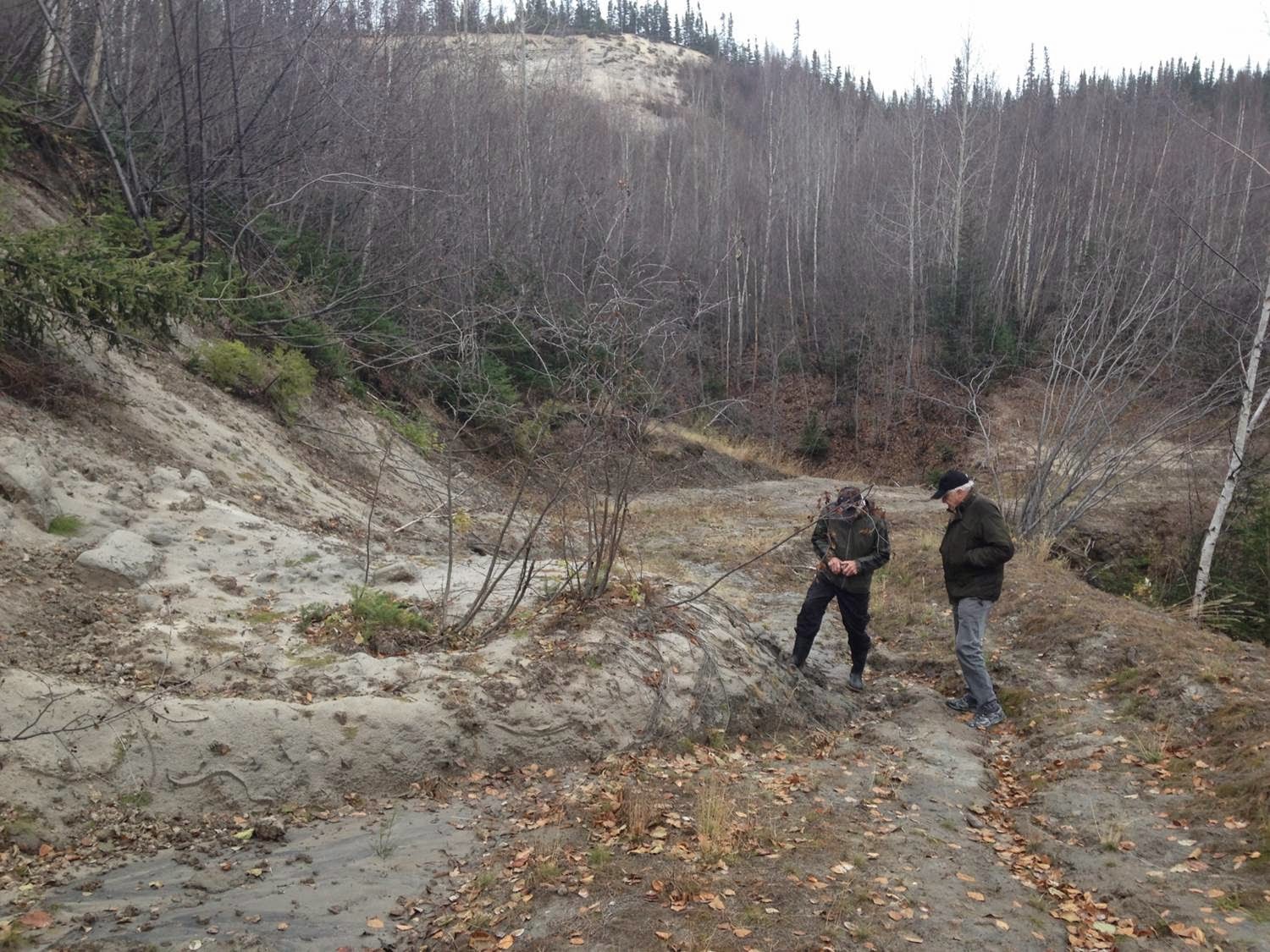 |
| Recent Slump Feature Near Bottom of North Spur |
While the issue is complicated, the lay person is
neither expected to run the data for Dr. Bernander’s engineering models nor required to check Nalcor’s
equations. The 170 or so people, engineers, lawyers, university professors,
other professionals and lay people of all backgrounds, who ventured out amidst
wind and rain, to fill the LSPU Hall last Thursday night, knew that.
based upon the opinions of a recognized expert, how deep their sense of concern
ought to be.
the viability of the Muskrat Falls project and that it lacked expertise in a critical area.
Bernander did not come to Newfoundland and Labrador to slake Nalcor.
now returned to Sweden, likely knows
Nalcor is our problem; not his.
__________________________________________________________
Related Reading:
LECTURE by Dr. Stig Bernander on “Quick Clay” and the North Spur LSPU Hall,
St. John’s, NL October 30, 2014
But Dr.
Bernander was able to make one thing clear to every person who attended: the risk of landslides exist not just along the
shoreline of the North Spur (the “toe”) but much higher up the slope, too.
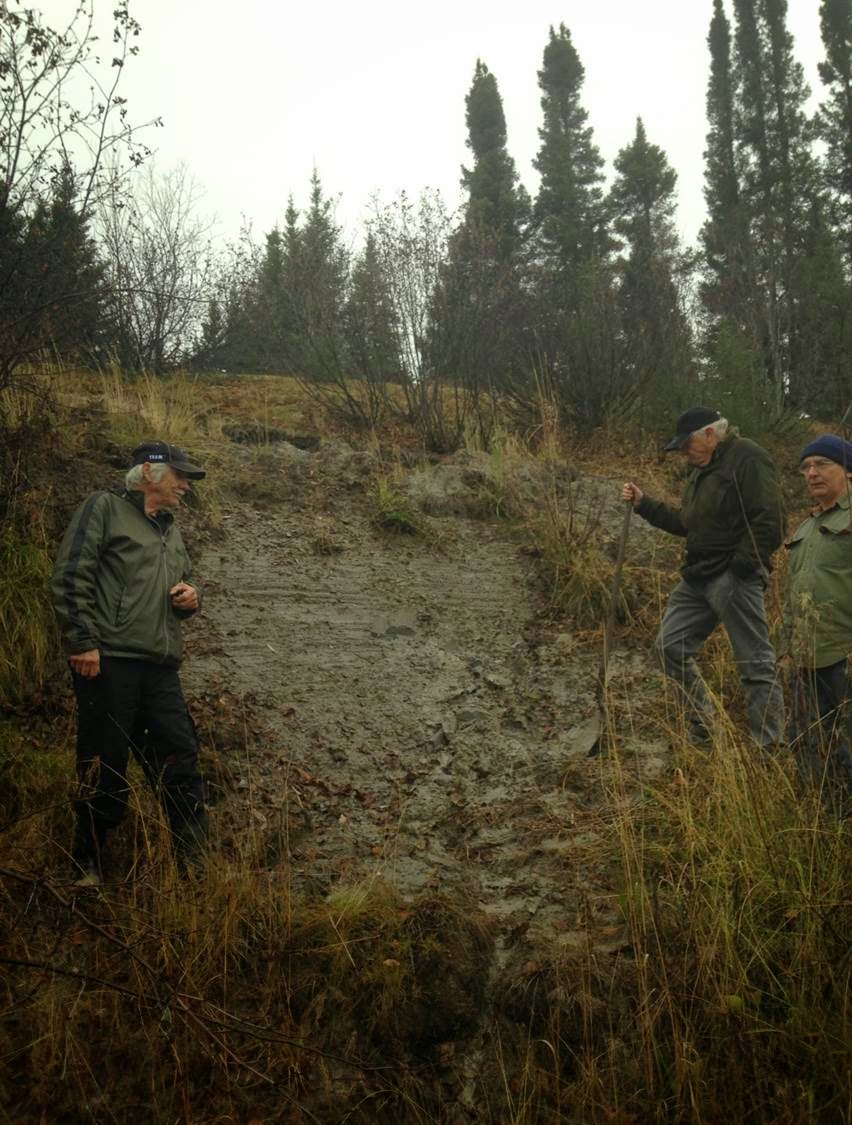 |
| Marine Clay, north west of TLH near Lower Brook Bridge |
More
specifically, Dr. Bernander states:
“predictions of slope stability have to be based on reliable analyses
according to present know-how and R & D, and that particularly in respect of
possible hazards related to brittle failure formation in the highly sensitive
clays of the North Spur.”
Dr. Bernander: “Generally, the Nalcor
report (sent to me 2014-08-27 for review) offers little information to anybody
wanting to do a critical evaluation of some of the important geotechnical
issues….especially regarding possible stability problems related to the
impoundment on the upstream side of the North Spur, as well as to the possible
impact of various construction measures in connection with the dam project.
insufficient information is presented on several subjects related to soil
mechanics and to slope stability.
continues: “The report indicates little focus on slope stability hazards
related to the possibility of Progressive Slope Failure formation in the quick
clays.”
Little wonder Bernander would be worried. His eyes are cast a good distance up slope while the Nalcor V-P`s are cast down.
Gilbert Bennett sat down with the Telegram back in August of this year, 2014. He told the Paper to dismiss the importance of the slides upstream and downstream (see photos); he spoke of Nalcor’s Plan for remediation of the lower part, the “toe” of the North Spur, stating:
The plan involves flattening the spur by taking material off the top and adding material at the bottom, so that its steep sides are less likely to calve off into landslides. Nalcor will also pile rocks at the base of the spur — essentially building a breakwater — both upstream and downstream of the Muskrat Falls dam to prevent waves from eroding it. On top of that, the construction work at Muskrat Falls involves building a concrete and bromite wall in the ground along the length of the North Spur, which will extend 45 metres below the water level.
The problem is Dr. Bernander believes the plan is not valid because Nalcor may not have used the right analysis to begin with.
Note that Bennett failed to discuss the higher sections of the Spur which extend in excess of 2km up over the steep slopes of the Churchill River towards the Trans Labrador Highway.
contributes very little to stability as compared to the active earth pressures
acting further uphill. A small
percentage change in the uphill active force is more dangerous than a larger
percentage change at the toe.”
Bennett seems not to possess knowledge of the “Progressive” and Retrogressive” slides, which can occur at the higher elevations; the details of which Dr. Bernander devoted much of his Lecture. Bernander warned that millions of cubic meters of sediments can move down over the Spur (or any other embankment comprised of “Quick Clay”) once any one of a multitude of forces (water, tremors, blasting, overloading to name a few) become a triggering mechanism.
Lecture not to represent Nalcor in a professional capacity but to express ‘pique’; not to show collegiality with the
internationally acclaimed expert, or provide a summary of Nalcor’s analysis, or as much as offer Dr. Bernander access Nalcor’s data
room.
Bennett forgets, too, that the money spent at Muskrat Falls is public money, not his
own.
Bernander visit as an opportunity for Nalcor to “strut its stuff”, as one
well-placed professional engineer suggested.
engineers, in general, have been warned, not by a layman but by one of their
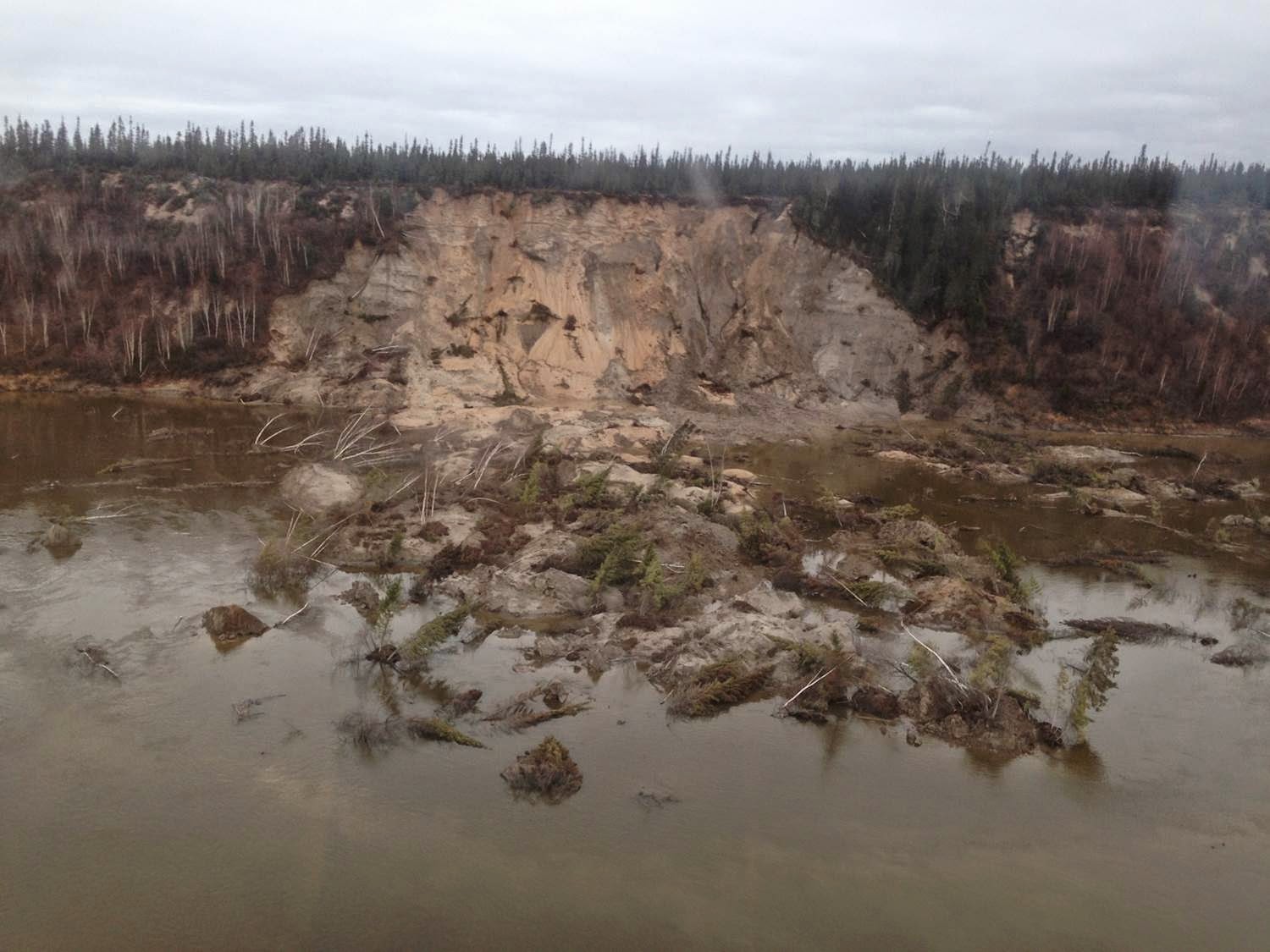 |
| 2014 slide north bank Lower Churchill River midway between Muskrat Falls and Goose Bay |
own,
Nalcor must not be allowed to just get away with words of “trust us”, to a public thatdoes not.
Association of Professional Engineers and Geoscientists (PEGNL) will have to show that
the word “professional” is a trademark intended to imply values of “integrity” equally with the requirement of “competence”.
If they believe Bernander’s claims are credible, knowing he is an expert in his field, they must ask Nalcor for its North Spur “Quick Clay” calculations and be satisfied that the Crown Corporation has competently addressed the issue. This, afterall, is a life safety issue.
is much in Dr. Bernander’s Lecture that is beyond the scope of this missive one other
item demands notice. Bernander took particular
note of this claim by Nalcor in a Report to the Independent Engineer. States Nalcor:
evidence of downhill progressive failure landslide along the Churchill river
valley.”
Swedish geoscientist: “…I am sceptical
towards this Nalcor assessment …. for many reasons. On our
investigation tour, many both ancient and recent landslide scars were seen
indicating downhill landslide formation and similar phenomena.” (emphasis added.)
It takes a
competent and confident organization to willingly submit to critical
examination by experts. Nalcor is not that confident; yet there is simply too much at stake to be wrong.
Crown Corporation now release all the geotechnical data and analysis, including
that which relates to the area above the “toe” of the North Spur or will it
wait for the issue to just go away?
concern over the safety of the residents of Mud Lake and Happy Valley-Goose Bay, as well as a hydro project already deep in financial hot water, ought to be key Government priorities.
where the new Premier is supposed to pick up the phone to Nalcor CEO Ed Martin
with instructions about his new and emphasis on transparency and accountability.
Like “Quick Clay”, overstressed, politics is very fluid right now.
But if the Premier should ever get a briefing on what a recognized expert has to say about the risks to the residents downstream of the North Spur and to the project itself, as well as a report on Bennett’s exhibition of bad manners, he will act decisively in the public interest.
Hubris must never be allowed to compete with people’s lives.
Premier Davis: please tear down the wall of secrecy at Nalcor!

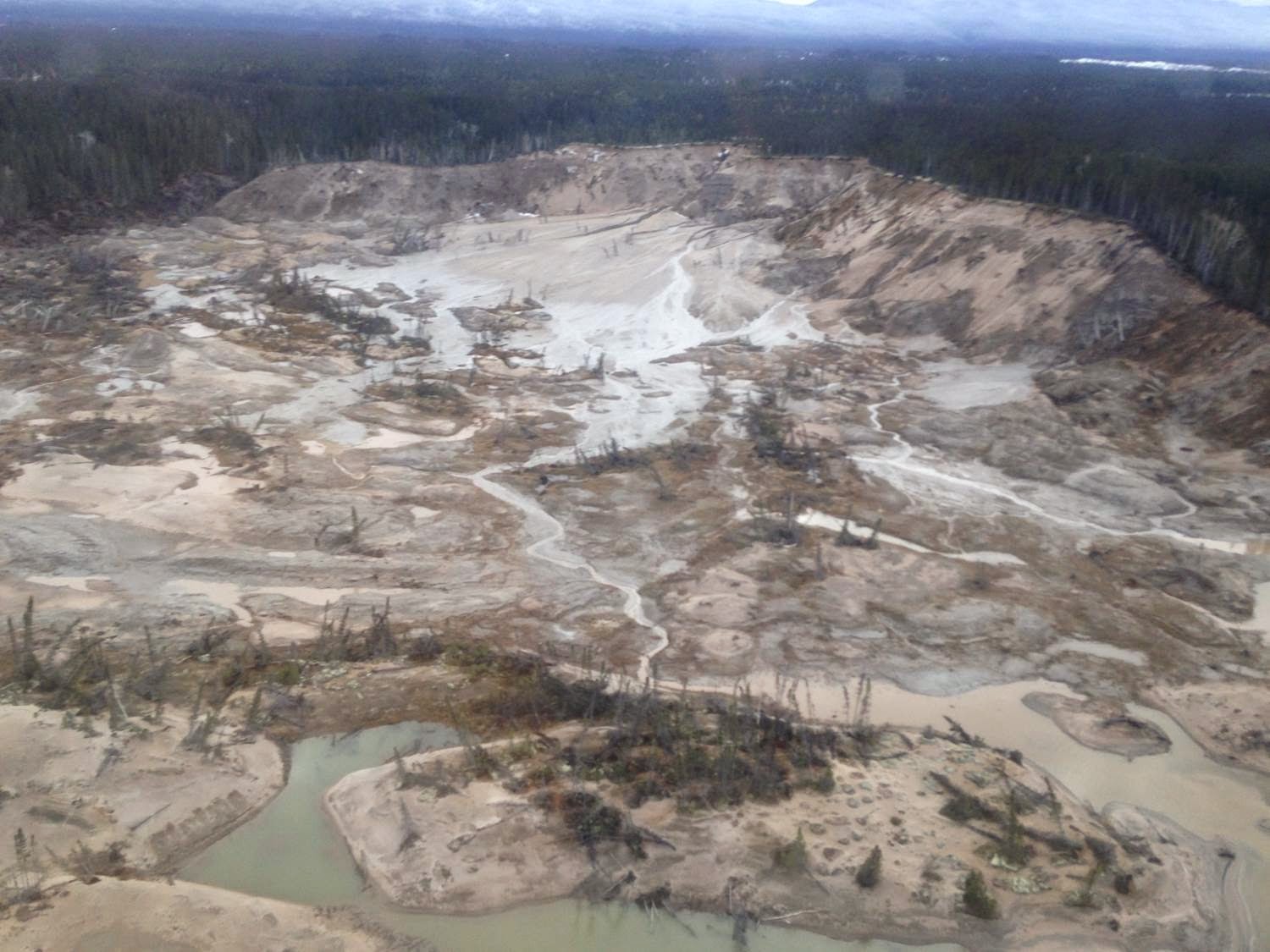
MF is liike The Emperor's New Clothes
You would Be a Lot more credible If you learned basic Rules of Capitalization.
This is indeed a life safety issue. There are many areas where dynamic rather than static analysis is appropriate. I believe Bernander gave an example whereby the difference in stress can be 8 fold. Bernander suggested that Nalcor approach is what was done in the last century, before the correct analysis for these type of slides with Quick Clay were well understood. He also stated that trusting to a natural dam situated on these marine clays is something that would not be done in Sweden. That he saw no evidence that Nalcor has done analysis showing what what level of earthquake the North Spur can endure, or that there was any plan to use piling to stabilize the North Spur. What to do?
Some suggestions:
1.Put the issue to the new Minister of Safety, Judy Manning, who has a reputation for resolving issues quickly, in 60 days or less.
2. Make a formal request to PEGNL, as to whether the right analysis is being used. I would assume the cost would be charged to Nalcor.
3. Have the town of Goose Bay seek proposals for insurance for all buildings and houses in the event of a failure of the North Spur from a quick clay failure, once the project goes on stream. High or low risk would be reflected in the insurance cost. Likely the insurance company would assess the design analysis as to the safety and chance of failure. Winston
Who can get Nalcor to